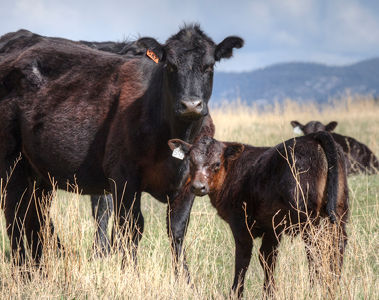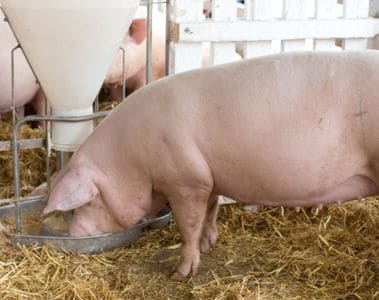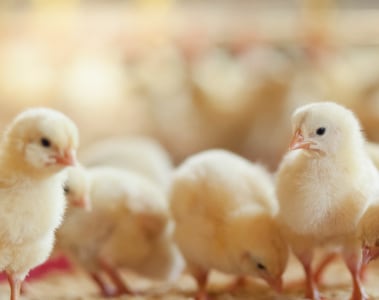1. Brana, D., J. Gabriel-Landon, J. Cervantes-Lopez and J.A. Cuaron. (2012) Nonruminant nutrition: Vitamins and Minerals. Journal of Animal Science. 98(Supp 1), 114.
2. Planchenault, D., B. Renouf, A. Meuter and J.M. Thoby. (2018) Effect of dietary 25-hydroxycholecalciferol and cholecalciferol on the performance of gestation and lactating sows and their litter. Journees Recherche Porcine. 50, 143-144.
3. Coffey, J.D., E.A. Hines, J.D. Starkey, C.W. Starkey and T.K. Chung. (2012) Feeding 25-hydroxycholecalciferol improves gilt reproductive performance and fetal vitamin D status. Journal of Animal Science. 90, 3783-3788.
4. Sugiyama, T., T.K Chung, H. Yonekura, E. Azem and T. Hayakawa. (2013) Effects of 25-hydroxycholecalciferol on the development of osteochondrosis in swine. Journal of Animal Science. 84, 341-349.
5. Konowalchuk, J. D., A. M. Riegea, M. D. Kiemele, D. C. Ayres and D. R. Barreda. (2013) Modulation of weanling pig cellular immunity in response to diet supplementation with 25-hydroxyvitamin D3. Veterinary Immunology and Immunopathology. 155(2), 57-66.
6. Zhao, Y., et al., Effects of phytase and 25-hydroxyvitamin D3 supplementation on growth performance and bone development in weaned piglets in Ca- and P-deficient dietary. Journal of the science of food and agriculture, 2022. 102(3): p. 940-948.
7. Zhao, Y., et al., Effects of phytase and 25-hydroxyvitamin D3 supplementation on growth performance and bone development in weaned piglets in Ca- and P-deficient dietary. Journal of the science of food and agriculture, 2022. 102(3): p. 940-948.
8. Zhao, Y., et al., Effects of phytase and 25‐hydroxyvitamin D3 supplementation on growth performance and bone development in weaned piglets in Ca‐ and P‐deficient dietary. Journal of the Science of Food & Agriculture, 2022. 102(3): p. 940-948.
9. Zhang, Z.W., et al., EFFECT OF 25-HYDROXYVITAMIN D3 AND DIVALENT CALCIUM ION SUPPLEMENTATION IN SOWS' DIETS ON TRACE ELEMENTS IN BLOOD AND MILK. JAPS: Journal of Animal & Plant Sciences, 2022. 32(1): p. 25-32.
10. Zhang, Z., et al., Effects of 25(OH)VD 3 on Growth Performance, Pork Quality and Calcium Deposit in Growing-Finishing Pigs. Animals (2076-2615), 2023. 13(1): p. 86.
11.. Yarger, J.G., et al., Safety of 25-hydroxycholecalciferol as a source of cholecalciferol in poultry rations. Poultry science, 1995. 74(9): p. 1437-1446.
12. Yang, J., et al., Dietary 25-Hydroxyvitamin D3 Supplementation Alleviates Porcine Epidemic Diarrhea Virus Infection by Improving Intestinal Structure and Immune Response in Weaned Pigs. Animals (2076-2615), 2019. 9(9): p. 627-627.
13. Woodworth, J.C., et al., Evaluating the impact of maternal vitamin D supplementation on sow performance: II. Subsequent growth performance and carcass characteristics of growing pigs. Journal of Animal Science, 2016. 94(11): p. 4643-4653.
14. Woodworth, J.C., et al., Evaluating the impact of maternal vitamin D supplementation on sow performance: II. Subsequent growth performance and carcass characteristics of growing pigs. Journal of Animal Science, 2016. 94(11): p. 4643-4653.
15. Wideman, J.R.F., et al., Efficacy of 25-OH Vitamin D3 prophylactic administration for reducing lameness in broilers grown on wire flooring. Poultry Science, 2015. 94(8): p. 1821-1827.
16. Wertz, A.E., et al., Feeding 25-hydroxyvitamin D3 to improve beef tenderness. Journal of Animal Science, 2004. 82(5): p. 1410-1418.
17. Weber, G.M., et al., Triennial Growth Symposium--Effects of dietary 25-hydroxycholecalciferol and cholecalciferol on blood vitamin D and mineral status, bone turnover, milk composition, and reproductive performance of sows. Journal of animal science, 2014. 92(3): p. 899-909.
18. Vinicius, D., et al., Inclusion of canthaxanthin and 25-hydroxycholecalciferol in the diet of broiler breeders on performance and incubation parameters. Ciência Rural, 2015. 45(11): p. 2050-2055.
19. Vignale, K., et al., 25-Hydroxycholecalciferol Enhances Male Broiler Breast Meat Yield through the mTOR Pathway1–3. The Journal of Nutrition, 2015. 145(5): p. 855-863.
20. Vazquez, J.R., et al., Effects of 25-hydroxycholecalciferol with two D3 vitamin levels on production and immunity parameters in broiler chickens. Journal of Animal Physiology & Animal Nutrition, 2018. 102(1): p. e493-e497.
21. Upadhaya, S.D., et al., Dietary 25(OH)[D.sub.3] supplementation to gestating and lactating sows and their progeny affects growth performance, carcass characteristics, blood profiles and myogenic regulatory factor-related gene expression in wean-finish pigs. Animal Bioscience, 2022. 35(3): p. 461.
22. Tatara, M.R., et al., Effects of dietary calcium content and vitamin D source on skeletal properties in growing turkeys. British Poultry Science, 2011. 52(6): p. 718-729.
23. Sugiyama, T., et al., Effects of 25-hydroxy-cholecalciferol on the development of osteochondrosis in swine. Animal Science Journal, 2013. 84(4): p. 341-349.
24. Sommerville, B.A., et al., Effect of dietary calcium and phosphorus depletion on vitamin D metabolism and calcium binding protein in the growing pig. Hormone and metabolic research = Hormon- und Stoffwechselforschung = Hormones et metabolisme, 1985. 17(2): p. 78-81.
25. Soares, J.H., Jr., J.M. Kerr, and R.W. Gray, 25-hydroxycholecalciferol in poultry nutrition. Poultry science, 1995. 74(12): p. 1919-1934.
26. Rider, S., et al., Calcifediol is a safe and effective metabolite for raising vitamin D status and improving growth and feed conversion in rainbow trout. Aquaculture, 2023. 568: p. 739285.
27. Regassa, A., et al., Effects of 25-(OH)D3 on fecal Ca and P excretion, bone mineralization, Ca and P transporter mRNA expression and performance in growing female pigs. Journal of Environmental Science and Health - Part B Pesticides, Food Contaminants, and Agricultural Wastes, 2015. 50(4): p. 293-299-299.
28. Regassa, A., et al., Effects of 25-(OH)D3 on fecal Ca and P excretion, bone mineralization, Ca and P transporter mRNA expression and performance in growing female pigs. Journal of Environmental Science & Health, Part B -- Pesticides, Food Contaminants, & Agricultural Wastes, 2015. 50(4): p. 293-299.
29. Regassa, A., et al., Effects of 25-(OH)D3 on fecal Ca and P excretion, bone mineralization, Ca and P transporter mRNA expression and performance in growing female pigs. Journal of environmental science and health. Part. B, Pesticides, food contaminants, and agricultural wastes, 2015. 50(4): p. 293-299.
30. Regassa, A., et al., Effects of 25-(OH)D3 on fecal Ca and P excretion, bone mineralization, Ca and P transporter mRNA expression and performance in growing female pigs. Journal of Environmental Science & Health, Part B -- Pesticides, Food Contaminants, & Agricultural Wastes, 2015. 50(4): p. 293-299.
31. Pointillart, A., N. Fontaine, and M. Thomasset, Effects of vitamin D on calcium regulation in vitamin-D-deficient pigs given a phytate-phosphorus diet. The British journal of nutrition, 1986. 56(3): p. 661-669.
32. Panisson, J.C., et al., Free-range system and supplementation of 25-hydroxicholecalciferol increases the performance and serum vitamin levels in mixed-parity sows. Animal science journal = Nihon chikusan Gakkaiho, 2021. 92(1): p. e13592.
33. Nascimento, G.R.d., et al., Effect of different vitamin D sources and calcium levels in the diet of layers in the second laying cycle. Brazilian Journal of Poultry Science, 2014. 16(2): p. 37-42.
34. Mitchell, R.D., et al., Dietary 1,25-dihydroxycholecalciferol has variable effects on the incidences of leg abnormalities, plasma vitamin D metabolites, and vitamin D receptors in chickens divergently selected for tibial dyschondroplasia. Poultry science, 1997. 76(2): p. 338-345.
35. Mirakzehi, M.T., et al., The effects of dietary 1, 25-dihydroxycholecalciferol and hydroalcoholic extract of Withania somnífera root on bone mineralisation, strength and histological characteristics in broiler chickens. British Poultry Science, 2013. 54(6): p. 789-800.
36. Marques, M.F.G., et al., 25-Hydroxycholecalciferol As an Alternative to Vitamin D3 in Diets with Different Levels of Calcium for Broilers Reared Under Heat Stress. Brazilian Journal of Poultry Science, 2022. 24(3).
37. Luyckx, K.Y., et al., Efficacy of 25-OH Vitamin D3 prophylactic administration for reducing lameness in broilers grown on wire flooring. Poultry Science, 2015. 94(8): p. 1821-1827.
38. Lütke-Dörhoff, M., et al., Dietary supplementation of 25-hydroxycholecalciferol as an alternative to cholecalciferol in swine diets: A review. Journal of animal physiology and animal nutrition, 2022. 106(6): p. 1288-1305.
39. Lütke-Dörhoff, M., et al., Dietary supplementation of 25-hydroxycholecalciferol as an alternative to cholecalciferol in swine diets: A review. Journal of animal physiology and animal nutrition, 2022. 106(6): p. 1288-1305.
40. Lim, C.I. and K.S. Ryu, Interactive effect of dietary levels of calcium and 25-hydroxy vitamin D3 on the performance, serum biochemical concentration and digestibility of laying hens from 61 to 70 weeks of age. Animal Bioscience, 2022. 35(9): p. 1426.
41. Lauridsen, C., et al., Reproductive performance and bone status markers of guts and lactating sows supplemented with two different forms of vitamin D. Journal of Animal Science, 2010. 88(1): p. 202-213.
42. Lauridsen, C., TRIENNIAL GROWTH SYMPOSIUM-- Establishment of the 2012 vitamin D requirements in swine with focus on dietary forms and levels of vitamin D. Journal of Animal Science, 2014. 92(3): p. 910-916.
43. Huang, K., et al., Effects of 25(OH)D 3 supplementation during late gestation on the serum biochemistry and reproductive performance of aged sows and newborn piglets. Journal of animal physiology and animal nutrition, 2021. 105(5): p. 908-915.
44. Heim, G., H. Weiser, and W.A. Rambeck, [Effects of different vitamin D metabolites on the leg weakness syndrome of turkeys]. Zeitschrift fur Ernahrungswissenschaft, 1990. 29(3): p. 178-183.
45. Hashim, M., et al., Ameliorative effects of 25-hydroxycholecalciferol levels on broiler chickens challenged with infectious bronchitis coronavirus: A novel approach. Journal of Applied Poultry Research, 2022.
46. Han, J.C., et al., Evaluation of relative bioavailability of 25-hydroxycholecalciferol to cholecalciferol for broiler chickens. Asian - Australasian Journal of Animal Sciences, 2016. 29(8): p. 1145.
47. Han, J.C., et al., Evaluation of relative bioavailability of 25-hydroxycholecalciferol to cholecalciferol for broiler chickens. Asian - Australasian Journal of Animal Sciences, 2016. 29(8): p. 1145.
48. Gonzales, E., et al., In ovo supplementation of 25(OH)D3 to broiler embryos. Brazilian Journal of Poultry Science, 2013. 15(3): p. 199-202.
49. Garcia, A.F.Q.M., et al., Use of vitamin [D.sub.3] and its metabolites in broiler chicken feed on performance, bone parameters and meat quality. Asian - Australasian Journal of Animal Sciences, 2013. 26(3): p. 408.
50. Flohr, J.R., et al., Effects of supplemental vitamin D3 on serum 25-hydroxycholecalciferol and growth of preweaning and nursery pigs. Journal of Animal Science, 2014. 92(1): p. 152-163.
51. Ferket, P.R., et al., Organic trace minerals and 25-hydroxycholecalciferol affect performance characteristics, leg abnormalities, and biomechanical properties of leg bones of turkeys. Poultry Science, 2009. 88(1): p. 118-131.
52. Duarte, V., et al., Inclusion of canthaxanthin and 25-hydroxycholecalciferol in the diet of broiler breeders on performance and incubation parameters. Inclusão de cantaxantina e 25-hidroxicolecalciferol na dieta de matrizes de corte sobre desempenho e parâmetros de incubação., 2015. 45(11): p. 2050-2055.
53. Bello, A., et al., Effects of the commercial in ovo injection of 25-hydroxycholecalciferol on broiler posthatch performance and carcass characteristics. Poultry Science, 2014. 93(1): p. 155-162.
54. Bello, A., et al., Effects of the commercial in ovo injection of 25-hydroxycholecalciferol on the hatchability and hatching chick quality of broilers. Poultry Science, 2013. 92(10): p. 2551-2559.
55. Bello, A., et al., Effects of the in ovo injection of 25-hydroxycholecalciferol on the yolk and serum characteristics of male and female broiler embryos. Poultry Science, 2015. 94(4): p. 734-739.
56. Bello, A., et al., Effects of commercial in ovo injection of 25-hydroxycholecalciferol on bone development and mineralization in male and female broilers. Poultry Science, 2014. 93(11): p. 2734-2739.
57. Bello, A., et al., Effects of commercial in ovo injection of 25-hydroxycholecalciferol on broiler bone development and mineralization on days 0 and 21 posthatch. Poultry Science, 2014. 93(5): p. 1053-1058.
58. Bajwa, M.H., et al., COMPARATIVE EFFICANCY OF VITAMIN D SOURCES ON GROWTH RESPONSE AND BONE MINERALIZATION IN BROILERS. Pakistan Journal of Agricultural Sciences, 2020. 57(1): p. 255-261.


